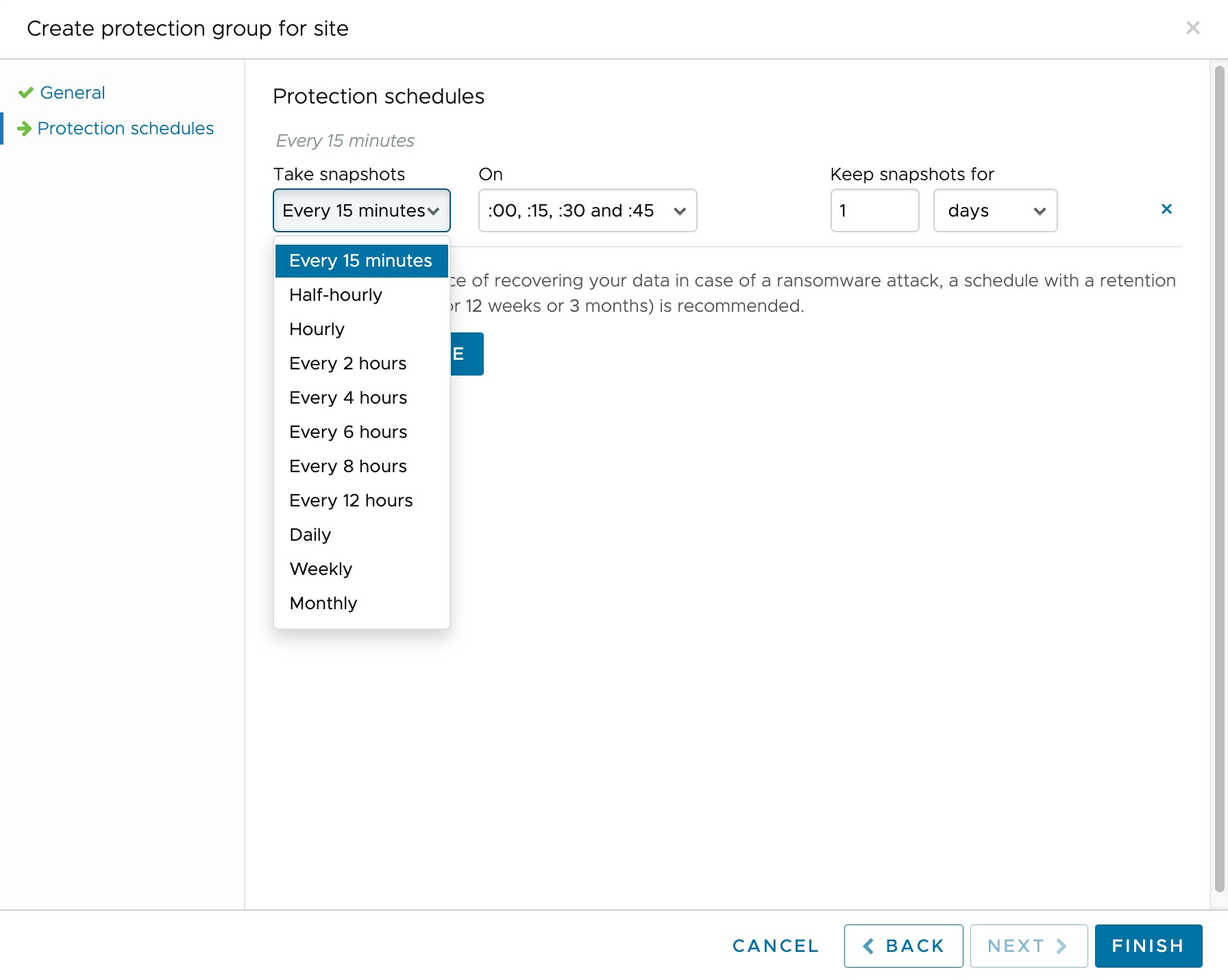You can configure protection groups with high-frequency snapshots with up to 200 VMs to achieve 15 minute RPO.
You can achieve 15 minute RPO when you create a protection group and add a 15 minute snapshot schedule. The default and recommended retention time for 15 minute snapshot schedules is 1 day.
Note: The maximum number of VMs with 15 minute RPO can vary, depending on the network bandwidth and the change rates per-disk.

Caveats and Restrictons
- 15 minute RPO is only available for high-frequency snapshots. To enable high-frequency snapshots, your protected site must be running vSphere 7.0 Update 3 or higher, and your protected SDDCs must be running version 1.16 or higher. For the latest release information on vSphere 7.0 Update 3, see these product release notes.
- Up to 200 VMs per-cloud file system are supported.
- 15 minute RPO does not work on a first time snapshot of a VM. The VMs in the protection group must already have snapshots taken before attempting 15 minute RPO.
- VMs with a high change rate and large snapshot deltas might not achieve a 15 minute RPO. In such cases, snapshots could take longer than 15 minutes to complete.
- 15 minute RPO can be affected if other snapshot jobs are running at the same time.
- If your environment has a slow network connection, low throughput might affect the ability to transfer the entire delta within 15 minutes.
- 15 minute RPO can be affected by the number as well as the size of VM disks. For example, a VM with a 32TiB disk, or a VM with 8 disks with disk sizes between 1 and 4 TiBs, might not be able to achieve 15 min RPO.
Procedure
- From the left navigation, select Protection groups.
- From the upper-right, click the Create protection group button.
- In the Create protection group for site dialog box, enter a name for the group.
- Next, select a protected site and a vCenter instance you want to take snapshots from.
- After you select a protected site and vCenter, the protection group automatically checks the protected site for compatibility with the high-frequency snapshot feature. If the protected site host is compatible with high-frequency snapshots, it is automatically selected.
- Next, define the dynamic membership of the protection group using VM name patterns, tags and/or VM folders in a vCenter query. The protection groups will contain all VMs that match the queries. Under Group membership, click the VM name pattern, Tags, or Folder buttons.
- For a VM name pattern query, enter a VM name pattern that is evaluated before a snapshot is taken. You can also enter a name pattern in the query in the Excluding text box for exclusion. (If there is already one vCenter query, then from the Add vCenter query drop-down menu select VM name pattern.)
- For a folder query, click the Select folders button. In the vCenter folders dialog box, search the list of folders in your vCenter and click one to add it. (If there is already one vCenter query, then use the Add vCenter query drop-down menu and select Folders.) Folder selection does not include sub folders, so you must select subfolders specifically.
- For a tag query, click the Tags button. In the vSphere tags dialog box, select tags to define protection group membership. Any VMs with selected tags are included in the protection group snapshots. Click OK when you finish.
- Click Preview VMs to see VMs that match the queries.
- Click Next.
- To set the snapshot schedule, click New Schedule.
- On the Schedule page, edit the snapshot schedule and select 15 minutes, and accept the 1 day for the snapshot retention under 'Keep snapshots for'.
- Optionally, you can add a custom name for the snapshot schedule. Click once in the default schedule name field above the schedule, enter a custom name, and then press Enter on your keyboard.
Here you can create additional snapshot schedules by clicking the
New Schedule button.
- When you have finished adding snapshot schedules and retention, click Finish. When the protection group appears in the Protection groups list, you can add it to a recovery plan for testing and disaster recovery and ransomware recovery operations.
